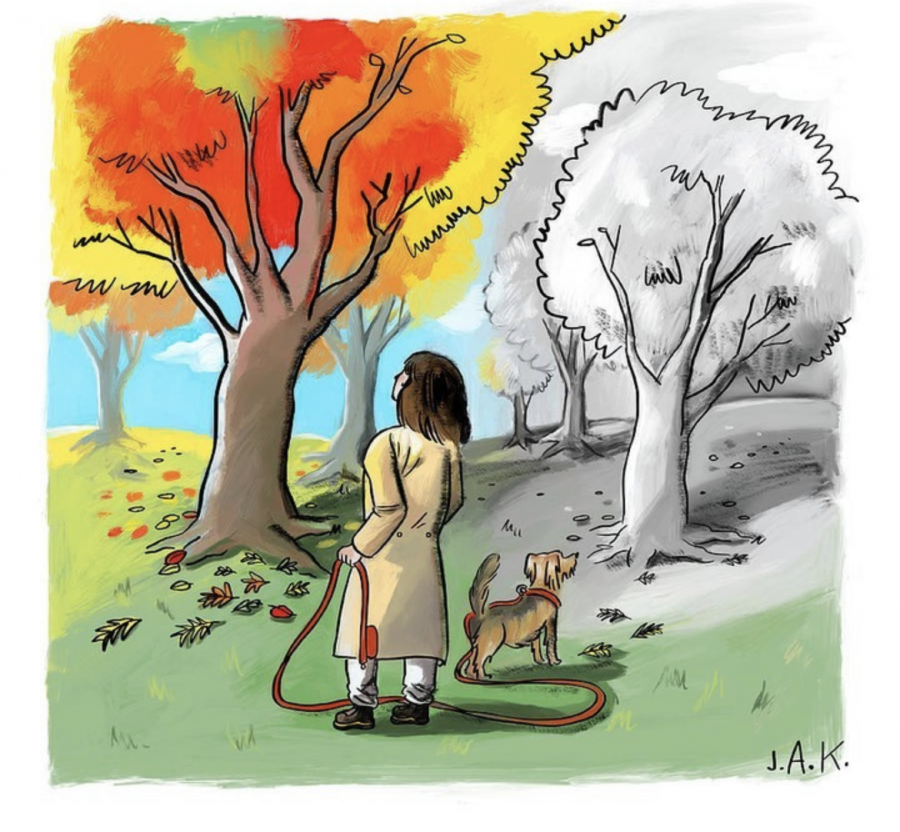As the Days Get Shorter, Seasonal Depression Worsens
Oftentimes, students find themselves experiencing more sadness in the winter: Here are some ways to combat it.
Cartoon courtesy of @NEWYORKERCARTOONS on Instagram
For some, fall’s cheery colors give way to winter’s bleakness.
December 31, 2021
“The sun has been setting at 4:00 p.m. every day and I hate it,” laments Sofia Bruno (‘22). The end of daylight savings time can be the beginning of a dark period in more ways than one. When daylight savings ends, it may have a negative effect on mood that adversely affects those living in the Northern Hemisphere. Seasonal depression is not an uncommon phrase to hear thrown around in the winter, but it is a very real issue. Seasonal affective disorder is a clinical disorder– not a made-up affliction.
According to Psychology Today, seasonal affective disorder is a seasonally occurring major depressive disorder. This means that those experiencing seasonal depression may exhibit many of the same symptoms as depression, such as loss of interest in regular activities, anxiety, difficulty concentrating, and withdrawal from social interaction. The difference, however, is that the symptoms of seasonal affective disorder typically only show up during the fall and winter, and clear up in the summer and spring.
Why does this happen? There are multiple contributing factors. The first is a shift in circadian rhythms: one’s “internal clock.” The change in daylight and hour gained due to daylight savings throws off the body’s 24-hour cycle. “When there is a shift in the season and our access to daylight, our bodies struggle to adjust to the new light and time frame,” explains Cleveland Clinic psychologist Susan Albers. The challenge of adjusting can be attributed to melatonin and serotonin, hormones associated with sleep patterns and mood. According to New York City-based neuropsychologist Sanam Hafeez, “Lack of sunlight suppresses the production of two important hormones, serotonin and sleep-inducing melatonin, both of which play an important role in mood balance. […] A person’s level of serotonin and melatonin decreases when there is less sunlight, which may lead to symptoms of depression.” Although the end of daylight savings only causes a one hour time difference, its effects on important hormones can negatively affect both mood and mental health.
Luckily, there are steps one can take to try to avoid seasonal depression. Establishing a routine is a great way to stay consistent despite the changing daylight hours. Cleveland Clinic recommends working out, eating healthy, and seeing friends. These small but important tasks all fit comfortably into a routine and help to combat seasonal depression. In addition to a routine, it’s important to spend time outside every day and take advantage of what little daylight there is. When there’s not enough light outside, one can turn to methods such as light therapy inside their own home. As reported by Cleveland Clinic, phototherapy (light therapy) is the use of a special lamp up to “20 times brighter than regular indoor light,” each morning. Results appear quickly, often taking only three days to decrease seasonal affective disorder’s effects.
If seasonal affective disorder goes untreated, symptoms can worsen. According to Mayo Clinic, seasonal affective disorder can spiral into substance abuse, social withdrawal, suicidal thoughts and behaviors, anxiety, or eating disorders. If one is struggling with seasonal affective disorder, it should not be taken lightly; take action by seeking help.
Seasonal depression is difficult to overcome but, fortunately, it is treatable. With the help of preventative measures, even those suffering can eventually enjoy the winter months.






